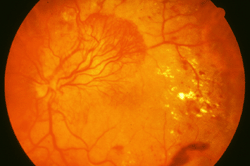|
|
|
Diabetes causes damage to the blood vessels that nourish the retina,
the seeing part at the back of the eye. In people with diabetes the retinal
blood vessels may expand and leak fluid. This is an early form of diabetic
retinopathy called nonproliferative or background retinopathy. You may
not notice any change in your vision when you develop this early form of
the disease, but it can lead to other more serious forms of retinopathy
that affect your vision.
When fluid collects in the macula (the part of the retina that allows
us to see fine details), reading and other close work may become difficult.
This is called macular oedema.
In other people abnormal, fragile new blood vessels may grow on the
surface of the retina. This is termed proliferative retinopathy. These
new blood vessels are called neovascularization, and can lead to serious
vision problems, because the new vessels can break and bleed into the vitreous.
(The vitreous is the clear, jelly-like substance that fills the centre
of the eye.) When the vitreous becomes clouded with blood, light is prevented
from passing through the eye to the retina. This can blur or distort vision.
The new blood vessels can also cause scar tissue to develop, which
can pull the retina away from the back of the eye. This is known as retinal
detachment, and can lead to blindness if untreated.



Retina affected by diabetic retinopathy
vision with diabetic retinopathy
Normal Retina
Who is at risk of developing diabetic retinopathy?
Every person with diabetes is at risk of developing diabetic retinopathy.
The longer a person has diabetes the more likely the person is to develop
diabetic retinopathy. Regular eye exams when first diagnosed with diabetes
and then at least every two years will reduce your risk of vision loss
and blindness. Tight control can delay the development of retinopathy.
What are the symptoms?
There are no symptoms in the early stages of diabetic retinopathy.
Vision may not change until the disease is advanced.
How is it detected ?
Diabetic retinopathy is detected during the eye examination of the
back of the eye with dilated (enlarged) pupils and by testing your vision.
An ophthalmologist, optometrist, your family doctor or a health worker
may conduct eye-screening examinations. Diabetic retinopathy can also be
detected during screening with a specie camera that photographs the back
of the eye without the use of dilating drops.
Can diabetic retinopathy be treated?
Yes. When sight threatening changes are detected you will be referred
to on ophthalmologist (an eye specialist) for further assessment and possible
treatment. Laser treatment is used to treat retinopothy. Laser is very
effective at maintaining vision but it cannot always restore vision that
has already been lost.
Things to Remember
? Everyone with diabetes is at risk of diabetic retinopothy.
? Vision loss due to diabetic retinopothy con be prevented if defected
and treated early.
? Eye examinations are essential when diabetes is first diagnosed and
then at least every 2 years.
? Tight control of your diabetes will delay the development of retinopathy.
? Take action before you notice any eye problems.
Have your eyes been checked
for diabetic retinopathy
in the last 2 years?
For More Information
Please call your family doctor